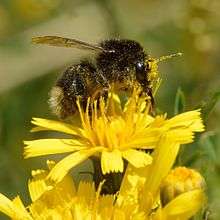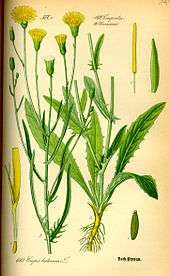Crepis tectorum
Crepis tectorum, the narrowleaf hawksbeard[2] or narrow-leaved hawk's-beard,[3] is an annual or winter annual plant that grows to 30–100 centimetres (12–39 in) high.[4] It is an invasive species and during maturity it has one main stem, which is branched, hairless, and leafy. The leaves are arranged in an alternate manner and are less than 0.5 inches (13 mm) wide. The Greek word krepis means sandal or slipper which resembles the shape of the seed.[5] Narrowleaf hawksbeard originated in Siberia and was introduced to Canada around 1890.[4]
| Crepis tectorum | |
|---|---|
.jpg) | |
| Inflorescence | |
| Scientific classification | |
| Kingdom: | Plantae |
| Clade: | Tracheophytes |
| Clade: | Angiosperms |
| Clade: | Eudicots |
| Clade: | Asterids |
| Order: | Asterales |
| Family: | Asteraceae |
| Tribe: | Cichorieae |
| Genus: | Crepis |
| Species: | C. tectorum |
| Binomial name | |
| Crepis tectorum | |
| Synonyms[1] | |
|
Synonymy
| |
Distribution
Crepis tectorum is native to most of Europe,[6] as well as northern and central Asia (Russia, Kazakhstan, Mongolia, and parts of China (Inner Mongolia, Heilongjiang, Xinjiang)).[7]
The species is now naturalized in much of Canada, Greenland, and northern parts of the United States including Alaska.[8] Narrowleaf hawksbeard is now commonly found in the parkland zone of Alberta, Saskatchewan and Manitoba.[4] Crepis tectorum is found in waste areas, conventional tillage, reduced tillage, forage and hay fields, and roadsides.[9][10]
Identification
Crepis tectorum is identified by its long, erect stem and yellow, dandelion-like flowers.[4] The leaves are pointed and lobed with a length of 10–15 centimetres (3.9–5.9 in) and width up to 4 cm (1.6 in).[4] The flower heads look like they contain single flowers, but in fact they contain many ray florets.[4]
Seedling
Crepis tectorum may look similar to a dandelion at this stage but will have teeth that point downward on the underside leaf margin.[10] The cotyledons are oval and the first true leaves are more elongated with petioles.
Juvenile
The juvenile stage of the narrowleaf hawksbeard is distinguishable by its rosette of leaves.[10] The stem may contain a milky-white latex.[10]
Mature
A mature Crepis tectorum plant will have dandelion-like flowers, with many flower heads on each stem.[10] When the plant had gone to seed it will have a white, fluffy head where the flower used to be.[10] The seeds are dark purple/brown achenes dispersed by the wind using hairs called the pappus.[4]
Habitat and ecology

Crepis tectorum is an annual weed that grows in cultivated fields and roadsides. It is very invasive so it can take over a field and lead to serious ecological impacts for the surrounding. Crepis tectorum is able to grow in calcareous soil as well as soil that does not contain lime.[4] However, it grows best in nutrient rich soils containing clays and loams.[4] It also thrives in dry, coarse soil. It grows with other species in the wild however, it becomes infectious if not controlled by humans. It can easily be removed by hand, although it can be controlled better by chemical means. The presence of the Narrowleaf hawksbeard is damaging to the soil and other species of plants nearby as it generally takes over the area. The temperature range for germination is 2–4 °C (36–39 °F), with an optimum depth of 3–4 cm (1.2–1.6 in).[11] Narrow-leaved hawksbeard grows on both calcareous and lime-deficient soils.
Morphology

Individuals of this species are usually approximately 3 feet (0.91 m) tall, single-stemmed, yellow petals on flowers, and produce 30–70 yellow ray florets.
Flowers and fruit
Inflorescences of Crepis tectorum are approximately ½-¾ inches wide and are hermaphrodite, having both male and female organs. It produces small flowers from June until September. The fruit is cylindrical shaped and dark brown. The fruit of Crepis tectorum is dry and is called an achene.[4]
Methods of control
Narrowleaf hawksbeard responds best to a fall application of 2,4-DB herbicide.[4] Non-chemical methods of control include spring or fall tillage to control winter annuals and the correct use of agronomic practices such as fertilization for the control of annuals.[4] Biological control can be achieved by insects, non-domestic animals, microorganisms, and viruses.[4] However, the use of biological control can be risky and should always be approached with caution.
References
- The Plant List, Crepis tectorum L.
- "Crepis tectorum". Natural Resources Conservation Service PLANTS Database. USDA. Retrieved 17 January 2016.
- "BSBI List 2007". Botanical Society of Britain and Ireland. Archived from the original (xls) on 2015-01-25. Retrieved 2014-10-17.
- H. G. Nadja, A. L. Darwent & G. Hamilton (1982). "The biology of Canadian weeds. 54. Crepis tectorum L.". Canadian Journal of Plant Science. 62 (2): 473–481. doi:10.4141/cjps82-067.
- "University of Wisconsin - Stevens Point". Archived from the original on 2011-09-28.
- Altervista Flora Italiana, Radicchiella dei tetti, Dach-Pippau, takfibbla, Crepis tectorum L. includes photos and European distribution map
- Flora of China, 屋根草 wu gen cao, Crepis tectorum Linnaeus, Sp. Pl. 2: 807. 1753.
- Biota of North America Program 2014 county distribution map
- Cooperative project with the U.S. Department of the Interior (2005). Invasive plants of Alaska. Washington, D.C.: U.S. Dept. of the Interior. pp. 63–65. ISBN 0-16-072996-3.
- C. J. Bubar, S. J. McColl & L. M. Hall (2000). "Weeds of the Prairies". Edmonton, AB: Alberta Agriculture and Rural Development.
- "AgroAtlas". Crepis tectorum.